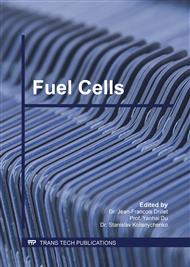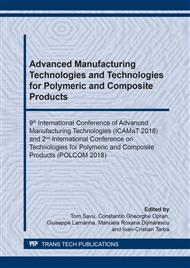p.329
p.340
p.348
p.358
p.369
p.379
p.389
p.399
p.409
Research Regarding Molding of Fuel Cell Bipolar Plates Made of Polymeric-Carbon Composites
Abstract:
Fuel cells are electrochemical devices that convert chemical energy of fuels into electrical energy. Fuel cells were used in NASA space programs to generate energy to satellites and space capsules. Today fuel cells are used to power vehicles including automobiles, forklifts, buses, boats, motorcycles or submarines. Bipolar plates are components of the fuel cell stack and must be highly electrically conductive to obtain a good voltage across the stack and highly thermally conductive to help cooling. Bipolar plates were made of graphite and stainless steel to which additional surface treatments were added to improve properties. In order to reduce the costs of bipolar plates researchers were looking for alternatives: polymeric thermosets and thermoplastics composites. In our paper we analyse the composites polyethylene-carbon and polypropylene-carbon for which we investigated the mechanical properties for the compression-moulded samples. The mechanical, the electrical properties and flow length and the cavity pressure were analysed for the injection moulding in polyethylene-carbon with micro-profiles of 0.5mm x 0.2mm.
Info:
Periodical:
Pages:
369-378
Citation:
Online since:
June 2019
Keywords:
Price:
Сopyright:
© 2019 Trans Tech Publications Ltd. All Rights Reserved
Share:
Citation:



